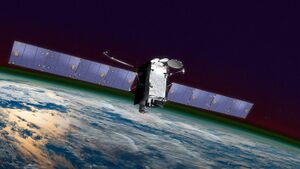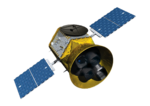Global-scale Observations of the Limb and Disk
Topic: Physics
 From HandWiki - Reading time: 5 min
From HandWiki - Reading time: 5 min
 SES-14 with GOLD (bottom left of satellite) | |
| Names | GOLD |
|---|---|
| Mission type | Observation of Earth's thermosphere and ionosphere |
| Operator | Laboratory for Atmospheric and Space Physics |
| COSPAR ID | 2018-012B |
| SATCAT no. | 43175 |
| Website | gold |
| Mission duration | 2 years (planned) [1] |
| Spacecraft properties | |
| Spacecraft type | Explorer |
| Manufacturer | Laboratory for Atmospheric and Space Physics |
| Launch mass | 36.8 kg (81 lb) [2] |
| Dimensions | 51 cm × 55 cm × 69 cm (20 in × 22 in × 27 in) [2] |
| Power | 72.4 watts [2] |
| Start of mission | |
| Launch date | 25 January 2018, 22:20 UTC[3] |
| Rocket | Ariane 5 ECA, VA241 |
| Launch site | Centre Spatial Guyanais, Kourou, ELA-3 |
| Contractor | Arianespace |
| Entered service | October 2018 |
| Orbital parameters | |
| Reference system | Geocentric orbit (planned) [4] |
| Regime | Geostationary orbit |
| Main Imaging spectrograph | |
| Wavelengths | Far ultraviolet[5] |
| Transponders | |
| Bandwidth | 6 Mbps [2] |
Global-scale Observations of the Limb and Disk (GOLD) is a heliophysics Mission of Opportunity (MOU) for NASA's Explorers program.[6] Led by Richard Eastes at the Laboratory for Atmospheric and Space Physics, which is located at the University of Colorado Boulder, GOLD's mission is to image the boundary between Earth and space in order to answer questions about the effects of solar and atmospheric variability of Earth's space weather.[7] GOLD was one of 11 proposals selected, of the 42 submitted, for further study in September 2011.[8] On 12 April 2013, NASA announced that GOLD, along with the Ionospheric Connection Explorer (ICON), had been selected for flight in 2017.[6] GOLD, along with its commercial host satellite SES-14, launched on 25 January 2018.[9]
Mission concept and history
GOLD is intended to perform a two-year mission imaging Earth's thermosphere and ionosphere from geostationary orbit. GOLD is a two-channel far-ultraviolet (FUV) imaging spectrograph built by the Laboratory for Atmospheric and Space Physics at the University of Colorado Boulder and flown as a hosted payload on the commercial communications satellite SES-14.[10] Additional organizations participating in the GOLD mission include the National Center for Atmospheric Research, Virginia Tech, the University of California, Berkeley, the University of Central Florida, Computational Physics Inc., the National Oceanic and Atmospheric Administration (NOAA), the U.S. Naval Research Laboratory (NRL), Boston University, and Clemson University.
In June 2017, SES announced the successful integration of GOLD with the SES-14 satellite under construction at Airbus Defence and Space in Toulouse, France .[11] GOLD was launched on 25 January 2018 at 22:20 UTC aboard Ariane 5 ECA VA241 from the Centre spatial Guyanais.[9]
Scientific objectives
The scientific objectives of the GOLD mission are to determine how geomagnetic storms alter the temperature and composition of Earth's atmosphere, to analyze the global-scale response of the thermosphere to solar extreme-ultraviolet variability, to investigate the significance of atmospheric waves and tides propagating from below the temperature structure of the thermosphere and to resolve how the structure of the equatorial ionosphere influences the formation and evolution of equatorial plasma density irregularities. The viewpoint provided by GOLD's geostationary orbit – from which the same hemisphere is always observable – is a new perspective on the Earth's upper atmosphere. This viewpoint allows local time, universal time and longitudinal variations of the thermosphere and ionosphere's response to the various forcing mechanisms to be uniquely determined.[7]
Results
Data from GOLD has been used to confirm that variation in the equatorial ionization anomaly at night and in the early morning is governed by atmospheric waves in the lower atmosphere. GOLD observations have also implicated gravity waves emanating from the lower atmosphere in the seeding of equatorial plasma bubbles, which degrade GPS performance.[12] GOLD daytime observations of the thermosphere column density ratio of atomic oxygen and nitrogen revealed new findings. First, GOLD observations showed that even weak or minor geomagnetic activity (maximum Kp=1.7) can still generate significant disturbances in the thermosphere and ionosphere. This is crucial for space weather forecasting because the pre-quiet condition before the disturbed time determines the accuracy of the forecast. Second, the neutral tongue, which is an enhancement of O/N2 surrounded by depletion of O/N2 and had only been seen in simulations, was first observed by GOLD. This modified the classic theory of thermospheric composition disturbance during storms. The theory predicted that the disturbance co-rotates from day to night but did not specify what else happens to the depletion.
References
- ↑ Mason, Tom (29 January 2018). "GOLD Powers on for the First Time". University of Central Florida. http://gold.cs.ucf.edu/gold-powers-on-for-the-first-time/.
- ↑ 2.0 2.1 2.2 2.3 Eastes, Richard (24 March 2016). "Global-scale Observations of the Limb and Disk (GOLD): Mission of Opportunity". Managing Partners and Resources, PI Team Masters Forum #6. NASA. https://appel.nasa.gov/wp-content/uploads/2017/02/Managing-Partners-and-Resources.pdf. Retrieved 5 December 2022.
- ↑ Nowakowski, Tomasz (25 January 2018). "Ariane 5 rocket places 2 satellites into orbit despite telemetry anomaly". Spaceflight Insider. http://www.spaceflightinsider.com/organizations/arianespace/ariane-5-rocket-places-2-satellites-into-orbit-despite-telemetry-anomaly/.
- ↑ "Trajectory: Explorer-1 1958-001A". NASA. 14 May 2020. https://nssdc.gsfc.nasa.gov/nmc/spacecraft/displayTrajectory.action?id=1958-001A.
 This article incorporates text from this source, which is in the public domain.
This article incorporates text from this source, which is in the public domain.
- ↑ Russell, Kendall (25 May 2017). "NASA Integrates Ultraviolet Space Spectrograph with SES 14". Satellite Today. http://www.satellitetoday.com/technology/2017/05/25/nasa-integrates-ultraviolet-space-spectrograph-ses-14/.
- ↑ 6.0 6.1 Brown, Dwayne (12 April 2013). "NASA Selects Explorer Projects to Probe Earth's Upper Atmosphere" (Press release). NASA. Retrieved 24 May 2013.
 This article incorporates text from this source, which is in the public domain.
This article incorporates text from this source, which is in the public domain.
- ↑ 7.0 7.1 Eastes, Richard (May 2009). "NASA Mission to Explore Forcing of Earth's Space Environment". Eos 90 (18): 155. doi:10.1029/2009EO180002. Bibcode: 2009EOSTr..90..155E.
- ↑ Brown, Dwayne (29 September 2011). "NASA Selects Science Investigations For Concept Studies" (Press release). NASA. Retrieved 24 May 2013.
 This article incorporates text from this source, which is in the public domain.
This article incorporates text from this source, which is in the public domain.
- ↑ 9.0 9.1 Clark, Stephen (26 January 2018). "Ariane 5 deploys two telecom satellites in orbit despite telemetry loss". Spaceflight Now. https://spaceflightnow.com/2018/01/26/ariane-5-va241-status-1/.
- ↑ Binette, Chad (15 April 2013). "$55 Million Grant Makes UCF, Florida History". University of Central Florida. http://today.ucf.edu/55-million-grant-makes-ucf-florida-history/.
- ↑ Payer, Markus; Kossobokova, Natalia (23 May 2017). "SES-14 Integrates NASA Ultraviolet Space Spectrograph" (Press release). SES. Retrieved 7 June 2017.
- ↑ Frazier, Sarah (14 January 2021). "Research Highlights from NASA's GOLD Mission". NASA. https://blogs.nasa.gov/sunspot/2021/01/14/research-highlights-from-nasas-gold-mission/.
 This article incorporates text from this source, which is in the public domain.
This article incorporates text from this source, which is in the public domain.
External links
- GOLD website by the University of Central Florida
- GOLD website by NASA
 |
 KSF
KSF
